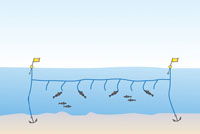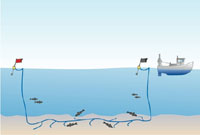 Longlines can be used to capture fish in surface waters (pelagic) as well as bottom living species (demersal). Longlining sets a length of line and from this come branch lines carrying baited hooks. Large longlines used offshore can be tens of kilometres long and carry thousands of hooks. Smaller inshore vessels use shorter, lighter lines with roughly less than a thousand hooks.
Longlines can be used to capture fish in surface waters (pelagic) as well as bottom living species (demersal). Longlining sets a length of line and from this come branch lines carrying baited hooks. Large longlines used offshore can be tens of kilometres long and carry thousands of hooks. Smaller inshore vessels use shorter, lighter lines with roughly less than a thousand hooks.
Examples of target species
- Tuna and swordfish (pelagic) and halibut and cod (demersal).
 Environmental summary
Environmental summary
- Habitat damage - longlines do not drag along the seabed so are not associated with damage to marine habitat.
- Bycatch of vulnerable species - longlines can unintentionally catch vulnerable species and high seas fisheries have been particularly associated with catching endangered seabirds, sharks and sea turtles.
- Discards - longlines can be associated with capture of non-target fish and other marine life.
Mitigation
Seabird bycatch on longline hooks can be reduced by the use of weighted lines, coloured bird-scaring streamers and fishing at night. Hook shape adaptations (such as a circle shape instead of J shaped) have helped to reduce shark and seaturtle bycatch in some fisheries.
Good Catch: Good Catch provides practical information for chefs, caterers and restaurateurs, making it easier for them to serve more sustainable seafood.
